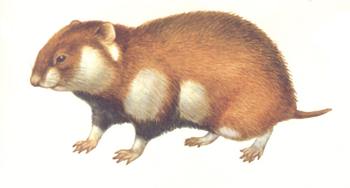Pests
Cricetus cricetus Linnaeus- Common or Black-Bellied Hamster.
Systematic position.
Class Mammalia, order Rodentia, family Cricetidae, subfamily Cricetinae, genus Cricetus. More than 10 subspecies have been described; there are no more than 7 described subspecies in the fauna of the Former Soviet Union.Morphology and biology.
This species is the biggest among hamsters, with body length to 350 mm. Tail length is to 58 mm; it is thick at base, thinning towards apex. Coloration is variegated; upper part of the body is ocherous-brown, the whole ventrum is black. Along sides of the body, in its anterior part, there are two large light spots separated by a black stripe. There is also a large light spot on each side of the head, and a small one behind each ear. Melanistic animals are also found. Diploid chromosome set is 22. The Common Hamster inhabits forest-steppes and steppes. It also penetrates deep into forest and semi-desert zones. In southern part of the area it inhabits wetter places, and is not found in arid regions. In foothills and mountains, the Common Hamster reaches the lower border of the forest belt; if the latter is absent, then this animal can reach mountain meadows. It avoids dense forests and boggy lowlands. It prefers to settle in compressed ground. It inhabits forest margins, bush thickets, agricultural lands, and meadows. This animal does not avoid human vicinity; it inhabits gardens, vegetable gardens, and even dwellings.Distribution.
The Common Hamster occurs widely within the Former Soviet Union: from its western boundary to Minusinsk Steppe forming the eastern limit of the area. In the north the limit of the area goes along the line Brest - Rovno - Gomel - Smolensk - Kholm - Rzhev - Yaroslavl - Kirov - Perm - southern parts of Tyumen Region. In the south the Common Hamster reaches Crimean and Caucasian Mountains, inhabits Volga (up to Vladimirovka) and Ural (up to Kulagino, or according to some evidence - to Guryev) river valleys. Further to the east: the lower Emba (Zhem) river and valley of the river Yrghyz - Kazakh Plateau - Zaisan and Alakol depressions - foothills of Dzhungarian Ala Tau (to the river Ili) - foothills of Tarbagatai and Altai. Some extension of the area is observed due to new agricultural lands in deforested places.Ecology.
Species has wide ecological flexibility. The Common Hamster is active at dusk and night. It is apt to aggression, and has a solitary lifestyle beyond the period of reproduction. This animal digs deep and complicated burrows, wintering ones especially. Burrow depth reaches 2.5 m. Sometimes the Common Hamster occupies burrows of ground squirrels. Spatial distribution of populations is sporadic. This animal is omnivorous, but vegetable food prevails in ration during the most part of the year; it prefers seeds of cereals, oil and legume crops, but eats also animal food (earthworms, insects, nestlings, young rodents). By autumn it completely transfers to the diet of grain, seeds, and tubers. The Common Hamster makes a large winter store of food, 10-16 kg and more. Hibernation is incomplete, animals appear on the surface during winter at low temperatures (-15° to -20°C) rather than during thaws only. It breeds twice or sometimes three times a year. On average, there are about 10 young hamsters in a brood, maximum to 20. Due to quick pubescence, short gestation period, and high reproduction intensity, the Common Hamster is succeptible to local rises of population density. It swims well and makes seasonal feeding migrations, sometimes for long distances.Economic Significance.
The Common Hamster is a serious pest of grain, vegetable, and fodder crops. In some places it destroys stores of agricultural products. Its harmful activity is favored by long periods of activity during a vegetation season and by strongly developed instinct of storing food. Its harmfulness has no mass character. Inhabiting fields of agricultural crops, the Common Hamster eats and treads out almost the whole vegetation around burrows, making bare places or so called .bald patches. of area to several tens of square meters. In some places this animal is actively hunted for its cheap and firm fur. The Common Hamster has important epidemical significance as a carrier of tularemia, leptospirosis, and other feral nidal diseases. Control measures are the same as for other rodent species, i.e., agronomical (high farming standards); chemical control by poisonous baits; mechanical catching with traps. Prophylactic and eradicative control measures are performed on a regular basis.Reference citations.
Dukelskaya N.M., Stepanova V.I. 1932. Some data on biology of Hamster and its control. In: Proceedings on Plant Protection, Leningrad, Series 4, Issue 2. 55-64 p. (In Russian)Gromov I.M., Erbaeva M.A. 1995. Mammals of Russia and adjacent territories. Lagomorphs and rodents. In: Aristov A.A., Baranova G.I., eds. Keys to Fauna of Russia. Issue 167. St. Petersburg: ZIN RAN, Zoological Institute of RAS. 522 pp. (In Russian)
Grulikh I. 1977. High rise in population density of Common Hamster (Cricetus cricetus L.) in Eastern Slovakia in 1971-1972. Bulletin MOIP, Section Biology, 82(6): 16-25. (In Russian)
Karaseva E.V., Shilyaeva L.M. 1962. Burrow structure of Common Hamster depending on its age and season of the year. Bulletin MOIP, Biology, 70(6): 30-39. (In Russian)
Kulik I.L. 1962. Materials to the ecology of Common Hamster in Altai. Byulleten MOIP, Biology, 67(4): 16-25. (In Russian)
Nechay G., Hamar M., Grulich I. 1977. The Common Hamster (Cricetus cricetus {L.}): A Review. European and Mediterranean Plant Protection Organization (EPPO) Bulletin, 7(2): 255-276.
Novikov K.L. 1932. Common Hamster. Moscow: Vneshtorgizdat. 18 p. (In Russian)


